|
Colors are fascinating. They’re all around, in every tint, tone, and shade, painting our world with such depth and vibrancy. But the origin of colors in our clothes, paint, and food, is mostly forgotten or simply unknown and untaught. So we’ll start with the primary colors and learn something together. The three primary colors are
Believe it or not, these three colors mixed together in an endless number of combinations, make up every color in the visible spectrum of light. If that’s a little confusing or you’ve never heard that term, I’ll be explaining “visible spectrum” with the next series covering secondary colors. For now we’ll be focusing on the less scientific but equally fascinating origin of color as it relates to dyes and pigmentation. -Primary Function: Kermes Vermilio- Red. The color most associated with passion. It makes us feel love, anger, strength; furious passion in all its forms. It’s a strong color that asserts its dominance in most people’s minds. My curiosity wants to know how humans came to harness this color outside of the spectrum of light. Where did it come from and how did we figure out how to wear it? One of the earlier forms of red dye was made from the dried bodies of the female of the insect species, kermes vermilio. Ancient Greeks and Romans used the kermes insects as red dye for their silks and wools. Jars of these dried and crushed insects were even found as far back as the Neolithic era. In the Middle Ages, kermes scarlet dyed cloth was seen as a symbol of status, desirability, and regality in England, France, Spain, and Italy. After the Middle Ages, roughly 1485, kermes was replaced by stronger, more versatile dyes made from other insects and from there it evolved into the synthetic dyes we have today. -Primary Function: I. Tinctoria- Blue. Heavily associated with tranquility and calmness; it also symbolizes trust, loyalty, and wisdom. When I see blue I think of water. Immediately I can hear it, I can smell it, and I want to be in a flowing stream away from the rest of the world. My mind then connects it to a peaceful blue sky with fluffy white clouds on a cool summer morning. Tranquility. This color carries good feelings. Creating this color in textiles started with the leaves of the plant, Isatis Tinctoria. Also known as woad, this plant started its journey in the desert areas of Caucasia and Central Asia and quickly spread throughout several countries. Like the kermes insect, this plant was also found in the Neolithic era. It made its way to the ancient Egyptian’s cloth wraps that they used for mummification and was found to be used to make Celtic blue body paint worn by the Picts of Northern Britain. It was attempted to be used as tattoo ink but turned out to scar when put under the skin. From the Medieval period, woad was mostly used for cloth but expanded again into paint pigmentation. For a while, woad thrived. It’s extracted chemical, Indigo, was so great that it became a controversial element in Germany and was banned from use as “the Devil’s dye” in 1577 and faced further issues in the indigo trade for the next 30 years. Of course the end drew near with the new development of synthetic dyes in the 20th century, rendering woad essentially useless outside of tradition. -Primary Function: Limonite- Yellow. A color of positivity, clarity, and happiness. Most associate it with bright thoughts and cheery moods, but it also has a connection to jealousy, cowardice, and caution. Like every other color though, how it makes you feel is entirely up to personal interpretation. For me I think of a field of animated sunflowers turning to face the sun with an adorable unified sigh of relief. The sunshiny tones of yellow pigment comes from iron(III) oxide-hydroxide, known as Limonite. Limonite is the main ingredient of the more known ochre family of pigments. Ochre has many shades and even spans into some reds that have been used as paints in ancient Australian, Paleolithic, and Neolithic burials. Because its brightness represented gold so well, yellow ochre paint was very popular in Ancient Egyptian tomb paintings. Using yellow ochre paint became common for interior painting in the ancient Mediterranean world and was widely used for painting panels and frescoes during the Renaissance. In the 1780’s, the process for making ochre pigment was industrialized by French scientist Jean-Étienne Astier and come the 20th century faced the same struggles as kermes and moad with the growing synthetic dye and pigment industry. But, unlike kermes and moad, ochre survived and is still used in products today, including tattoo ink. Learning where these pigments come from has been a fun and rewarding journey for me and I’m excited to get into the next series of color exploring the visible spectrum of light. I hope it’s been the same for you and that you join me for the next series of discoveries. “The beautiful thing about learning is that no one can take it away from you.”
-BB King-
3 Comments
|
About the Author:Art. Tattoos. Music. Food. Archives
March 2020
Categories |


